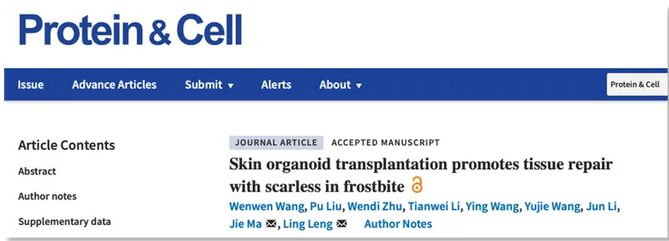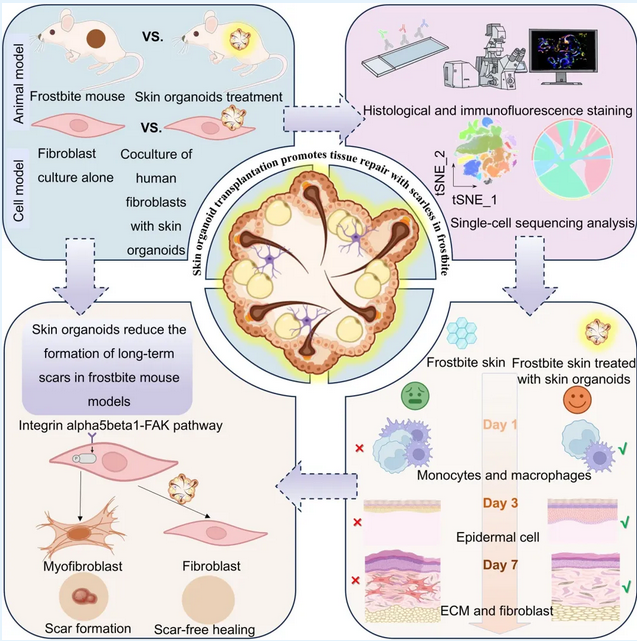Delayed frostbite healing not only leads to scar formation but can also result in amputation in severe cases, and may even develop into secondary malignant tumors. Accelerating frostbite wound healing remains a clinical challenge. Professor Leng Ling and her team at the Institute of Clinical Medicine, PUMCH, have developed a treatment that significantly accelerates wound healing and alleviates early inflammation after frostbite. This treatment combines human-induced pluripotent stem cell (hiPSC) -derived skin organoids with gelatin-hydrogel. The research was recently published in Protein & Cell (IF: 21.1), a journal ranked among the top 5% by the Chinese Academy of Sciences. This study was supported by the National High Level Hospital Clinical Research Funding and the Leading Health Talents Program under the Chinese Academy of Medical Sciences.

Frostbite, an injury caused by exposure to low temperatures, is a common emergency condition among people working in winter or under cold circumstances. Current treatments are still primarily traditional topical ointments. Compared to ordinary skin injuries, frostbite causes more complex damage and is harder to heal, making prevention, early diagnosis, and active treatment crucial. Over the past two decades, stem cell therapy has attracted widespread attention for its role in promoting rapid wound healing and epidermal regeneration. However, stem cell therapy alone cannot achieve scarless wound healing.
With advancements in stem cell research, organoid research has continued to progress. The formation of organoids can be simply described as "growing" miniature versions of human organs in the laboratory. The main steps include preparing the "seeds", "soil", and "nutrients", followed by “sowing and nurturing the seeds”. The "seeds" are stem cells; the "soil" refers to an environment suitable for stem cell growth and differentiation, usually including a 3D scaffold (such as matrix gel); and the "nutrients" are growth factors that promote stem cell growth and differentiation. When stem cells are "planted" on the 3D scaffold, they begin to grow and self-assemble. Researchers add various growth factors to simulate the in vivo cellular environment, after which the stem cells begin to differentiate, forming different cell types arranged in specific spatial structures, ultimately forming functional miniature simulated organs - organoids.
To investigate the mechanism of frostbite healing, researchers first constructed a mouse model of frostbite and performed single-cell transcriptome analysis of full-thickness skin frostbite progression in mice in combination with pathological analysis. Based on this, the researchers discovered the mechanisms leading to difficult healing and pathological scarring in frostbite. The research team then cultured full-thickness skin organoids from human induced pluripotent stem cells (hiPSC), complete with epidermis and appendages (such as hair follicles), dermis and fat tissue, and nervous system components, to treat second-degree frostbite.
The research found that transplanting skin organoids significantly accelerated frostbite wound healing. Pathological analysis showed marked improvement in inflammation and vascular damage, as the transplantation promoted rapid recovery of collagen expression in affected skin tissues. Researchers also found that the proportions of immune cells, including monocytes, macrophages, and Langerhans cells, were decreased in tissues with skin organoid one day after transplantation compared to those without treatment. This indicates that organoid treatment can regulate excessive inflammatory responses caused by repeated activation of inflammatory cells in damaged tissue, thereby inhibiting frostbite scar formation.

▲Skin organoids encapsulated in gelatin-hydrogel significantly promote scar-free healing of frostbite wounds
Professor Leng Ling stated that organoids show promise for broad application in promoting the reversal of frostbite-related injuries and restoration of skin function. This research provides new potential therapeutic options for patients suffering from scarring and skin dysfunction caused by frostbite and other difficult-to-heal injuries.
Written by Chen Xiao
Edited by Xiao Xiong
